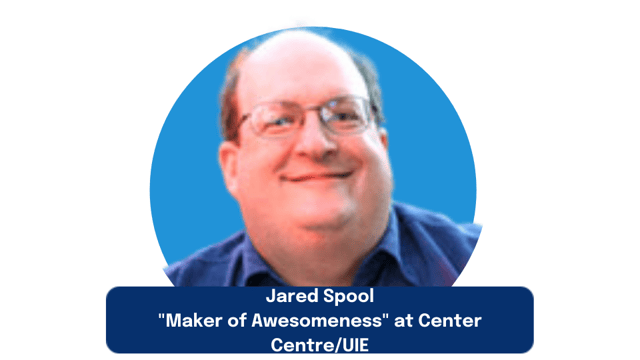User Experience Design is Product Management

Jared Spool, "Maker of Awesomeness" at Center Centre/UIE, shares how companies can make design a competitive advantage and two practices for creating a culture of continuous learning.
Jared Spool is a "Maker of Awesomeness" at Center Centre/UIE. Center Centre is the school he started with Leslie Jensen-Inman to create industry-ready User Experience Designers. UIE is Center Centre’s professional development arm, dedicated to understanding what it takes for organizations to produce competitively great products and services.
In the 39 years, he's been in the tech field, he's worked with hundreds of organizations, written two books, published hundreds of articles and podcasts, and tours the world speaking to audiences everywhere.
According to Jared, "the last sort of frontier for being competitive is the experience that the user/customer has, and that's what we focus on is how do you make your user experience, your customer experience more competitive." He describes the four stages of learning that teams need to move through to make user experience design a competitive advantage:
- Unconscious incompetence
- Conscious incompetence
- Conscious competence
- Unconscious competence
Companies in the fourth stage are "design mature," which as Jared explains:
means that they are producing better design products and services on a consistent basis to the point where that's the competitive edge where companies, organizations, or individuals are choosing to buy those products or services not because they're cheapest, not because they have some certain combination of features but because they're actually better designed products, and they can see that if they purchase better designed products or hire better designed services, they get better outcomes themselves.
He acknowledges that most people don’t learn the skills they need to be successful at work in school. Rather, on-the-job training is the best way to learn. To create a workplace environment that facilitates learning, Jared recommends creating a workplace environment that encourages learning and reflection.
We have to have time for practice, and we have to create that time. And then the other thing that's essential for learning is reflection. Sitting down and taking a moment and reflecting on what we've accomplished.
This can be accomplished by adding one more question to recurring standup meetings: "What have I learned since the last standup and how will that change what I do in the future?" When organizations encourage people to reflect on what they've accomplished and what made a difference, they start to see dramatic results.
Net Promoter Scores (NPS) are a perfect example of how to apply this framework. Jared criticizes NPS and explains how he would improve them:
I would change it to, what could we do to make this experience better? Or, if you really wanna go down the recommendation route, you could say, if you were to recommend us to a friend, what would you actually say? What would you tell someone who was thinking about buying this product or service? And either of those two questions will get you qualitative data. Unfortunately, you can't compare it to other companies, so you won't know how you performed against your competitors. But that's not really that important. What you really want to know is, how can you become better?
If companies can solve their users' problems better, even if their competitors aren't taking the same approach, they actually become more competitive. "Innovation doesn't need to be that complicated. It's really just really knowing the problem."
You’ll learn a lot from this episode about design leadership, learning, and measuring success.
Here are the highlights:
- What companies need to do to make design a competitive advantage (5:29)
- How product managers and designers can align on creating a great user experience (10:59)
- Jared shares his recommendations on creating a culture of continuous innovation (14:36)
- Jared discusses the value of the Net Promoter Score as a success metric (19:39)

Subscribe now!
Get our new reports, case studies, podcasts, articles and events

.png?width=80&name=Untitled%20design%20(1).png)